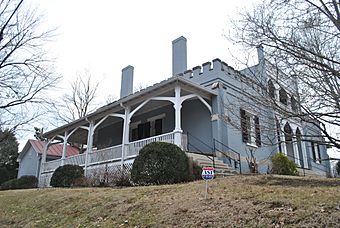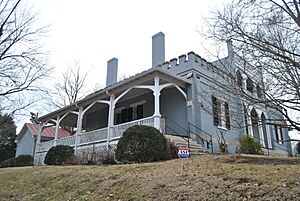Athenaeum (Tennessee) facts for kids
Quick facts for kids |
|
|
The Athenaeum
|
|
 |
|
| Location | Columbia, TN |
|---|---|
| Built | 1838 |
| Built by | Nathan Vaught |
| Architect | Adolphus Heiman |
| Architectural style | Exotic Revival, Gothic Revival |
| NRHP reference No. | 73001809 |
| Added to NRHP | April 24, 1973 |
The Athenaeum Rectory is a cool old building in Columbia, Tennessee. It has unique designs, mixing styles like Gothic and Moorish. Built in 1837, it was first the home for the president of the Columbia Female Institute, Reverend Franklin Gillette Smith. This historic place was added to the National Register of Historic Places in 1973.
Contents
Discovering the Athenaeum Rectory's Past
This special building, now known as the Athenaeum Rectory, started being built in 1835. It was first planned as the home for Samuel Polk Walker. He was the nephew of President James K. Polk.
A Home for the Columbia Female Institute's Leader
By 1837, when construction finished, the plans changed. The home became the residence for Reverend Franklin Gillette Smith. He was the first president of the Columbia Female Institute. This was an Episcopal school for girls in Tennessee.
In 1851, Rev. Smith left his role at the Columbia Female Institute. The school's co-founder, Bishop James Hervey Otey, asked him to resign. Bishop Otey then moved his family and work to Memphis, Tennessee. Memphis became the main center for Tennessee's bishops for many years.
The Columbia Athenaeum School's New Chapter
Rev. Smith still wanted to teach, so he started a new school. It was called the Columbia Athenaeum School. It was right next to the Columbia Female Institute. The Athenaeum Rectory continued to be the Smith family's home. It also had rooms for school events.
The Columbia Athenaeum School was open for 52 years, until 1903. It became famous across the country for its great classes. Reverend Smith believed girls were just as smart as boys. He offered subjects usually only taught to boys. These included calculus, physics, and marine biology. The school had twelve buildings in total.
After the school closed, the Smith family sold the property. A local high school used the buildings until 1914. In 1915, the City of Columbia built a new high school there.
The Smith family lived in the Athenaeum Rectory until 1973. Then, they gave it to a group that saves old buildings. This group is called the Association for the Preservation of Tennessee Antiquities. Today, the rectory is a historic house museum. People from Maury County can visit it. There is also a small cottage where Reverend Smith used to study. Twice a year, events are held to show what school was like for girls back then.
The Athenaeum Rectory's Unique Design
The Athenaeum Rectory is special because it combines many building styles. You can see parts of Gothic, Moorish, Greek Revival, and Italianate designs. Adolphus Heiman, a famous architect from the 1800s, designed the building. He designed many buildings in Middle Tennessee. Nathan Vaught, a skilled builder from Maury County, built the rectory.
Today, the restored home offers guided tours. You can explore its unique rooms and learn about its history.
Notable People Connected to the Athenaeum
- Bessie Alexander Ficklen (1861–1945), a talented writer, poet, and artist.
- Loraine Bedsole Bush Tunstall (1881-1953), a social reformer who worked to improve society.




